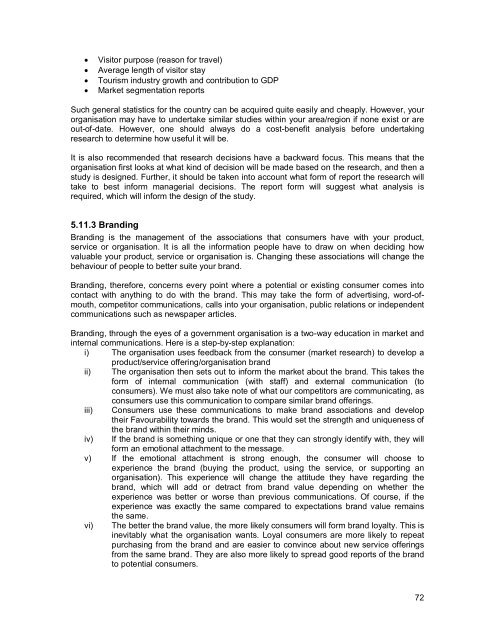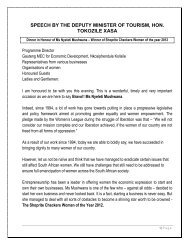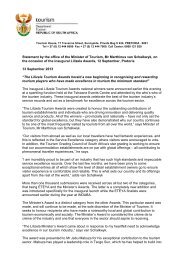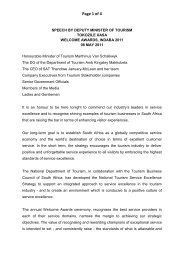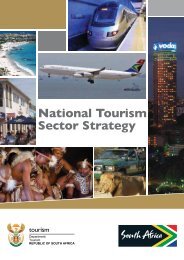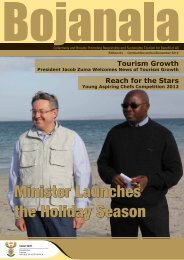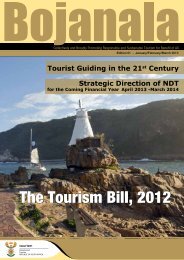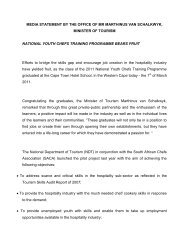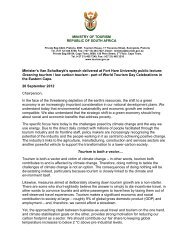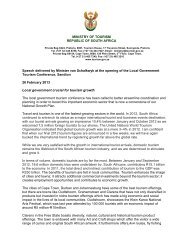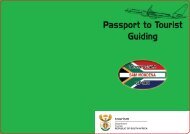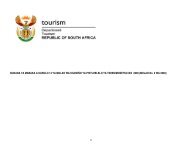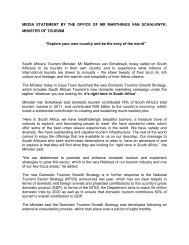The South African Tourism Planning Toolkit - Department of Tourism
The South African Tourism Planning Toolkit - Department of Tourism
The South African Tourism Planning Toolkit - Department of Tourism
Create successful ePaper yourself
Turn your PDF publications into a flip-book with our unique Google optimized e-Paper software.
Visitor purpose (reason for travel)Average length <strong>of</strong> visitor stay<strong>Tourism</strong> industry growth and contribution to GDPMarket segmentation reportsSuch general statistics for the country can be acquired quite easily and cheaply. However, yourorganisation may have to undertake similar studies within your area/region if none exist or areout-<strong>of</strong>-date. However, one should always do a cost-benefit analysis before undertakingresearch to determine how useful it will be.It is also recommended that research decisions have a backward focus. This means that theorganisation first looks at what kind <strong>of</strong> decision will be made based on the research, and then astudy is designed. Further, it should be taken into account what form <strong>of</strong> report the research willtake to best inform managerial decisions. <strong>The</strong> report form will suggest what analysis isrequired, which will inform the design <strong>of</strong> the study.5.11.3 BrandingBranding is the management <strong>of</strong> the associations that consumers have with your product,service or organisation. It is all the information people have to draw on when deciding howvaluable your product, service or organisation is. Changing these associations will change thebehaviour <strong>of</strong> people to better suite your brand.Branding, therefore, concerns every point where a potential or existing consumer comes intocontact with anything to do with the brand. This may take the form <strong>of</strong> advertising, word-<strong>of</strong>mouth,competitor communications, calls into your organisation, public relations or independentcommunications such as newspaper articles.Branding, through the eyes <strong>of</strong> a government organisation is a two-way education in market andinternal communications. Here is a step-by-step explanation:i) <strong>The</strong> organisation uses feedback from the consumer (market research) to develop aproduct/service <strong>of</strong>fering/organisation brandii) <strong>The</strong> organisation then sets out to inform the market about the brand. This takes theform <strong>of</strong> internal communication (with staff) and external communication (toconsumers). We must also take note <strong>of</strong> what our competitors are communicating, asconsumers use this communication to compare similar brand <strong>of</strong>ferings.iii) Consumers use these communications to make brand associations and developtheir Favourability towards the brand. This would set the strength and uniqueness <strong>of</strong>the brand within their minds.iv)If the brand is something unique or one that they can strongly identify with, they willform an emotional attachment to the message.v) If the emotional attachment is strong enough, the consumer will choose toexperience the brand (buying the product, using the service, or supporting anorganisation). This experience will change the attitude they have regarding thebrand, which will add or detract from brand value depending on whether theexperience was better or worse than previous communications. Of course, if theexperience was exactly the same compared to expectations brand value remainsthe same.vi)<strong>The</strong> better the brand value, the more likely consumers will form brand loyalty. This isinevitably what the organisation wants. Loyal consumers are more likely to repeatpurchasing from the brand and are easier to convince about new service <strong>of</strong>feringsfrom the same brand. <strong>The</strong>y are also more likely to spread good reports <strong>of</strong> the brandto potential consumers.72


